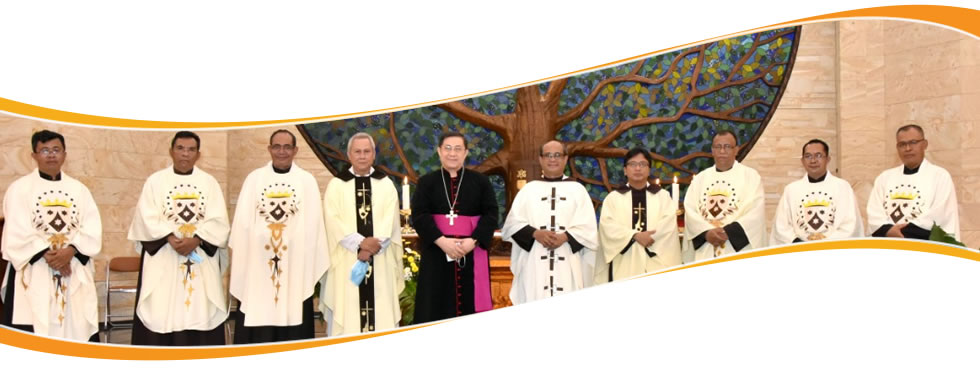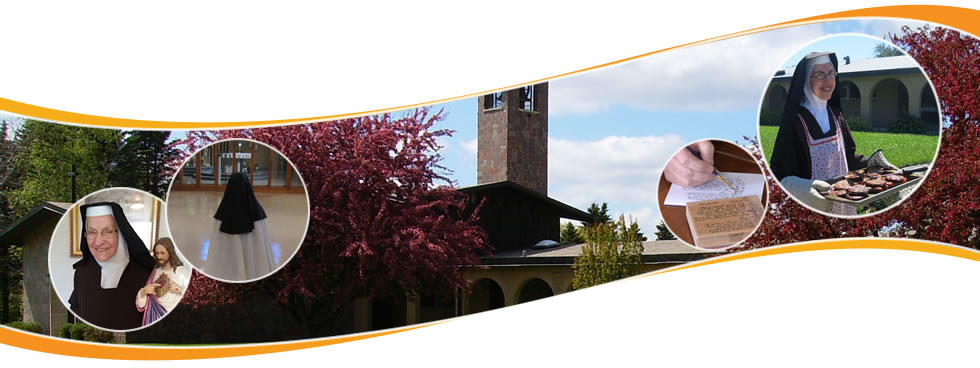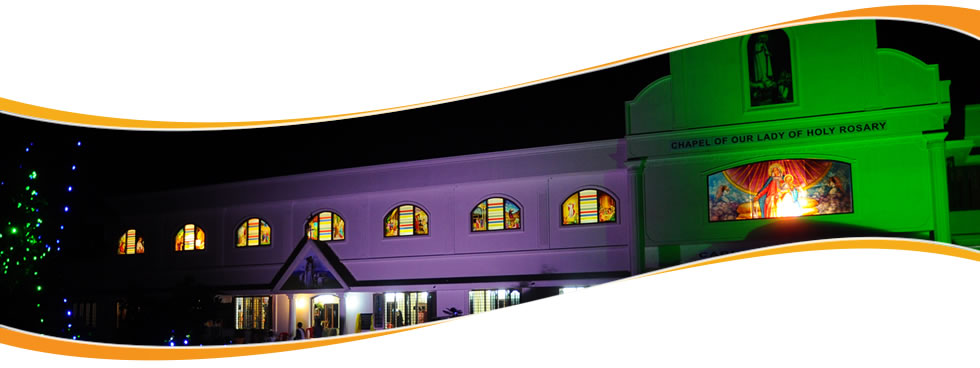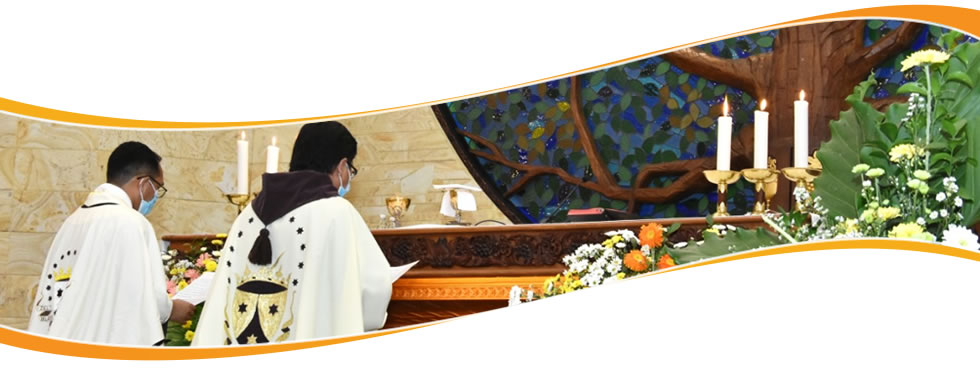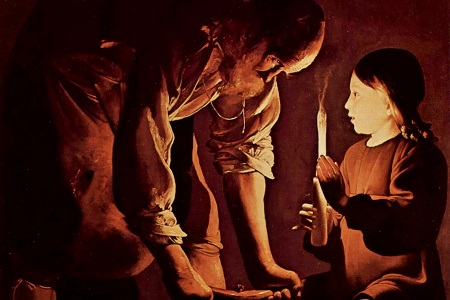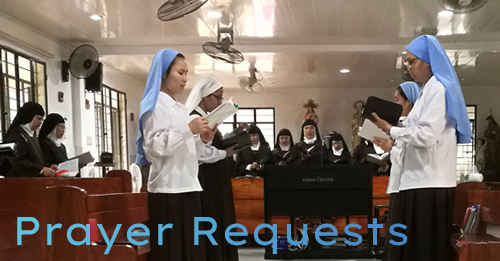In a lovely little booklet on St Joseph, Cardinal Suenens wrote:
“It has been said that the worst thing we can do to the saints is to put them on pedestals. In Joseph’s case, we might criticise not only the pedestal, but also the image of him with which we are all too often presented.”[1]
Another contemporary French writer A. Doze speaks of “misinformation” about him, and says that to misinform is to spread false rumours the better to lead people astray.[2]
Yet Saint Joseph is in some ways a shadowy figure. There is little about him in the New Testament, indeed one might wonder who his father was, since there is some discrepancy in the genealogies of Matthew and Luke: Matthew appears to think his father’s name was Jacob (see Matt 1:16); Luke seems to have him as the son of Heli (see Luke 3:23). At times Joseph appears to be airbrushed out of history. One finds pictures of the Adoration of the Magi with three or four eastern figures, but no Joseph. Yet one cannot deny the aptness of the title of a book popular in the middle of the last century, The Man Closest to Christ.[3] He has always had a secure place in the hearts of Catholic Christians throughout the second millennium.
In recent decades there has been renewed attention to him on the part of theologians and spiritual writers. There are two academic journals devoted to studies concerning the saint: Cahiers de joséphologie, published in Montreal since 1953 and Estudios josefinos from Valladolid since 1947. Pope John Paul II gave the Church a letter on the saint, “Guardian of the Redeemer: On the Person and Mission of Saint Joseph in the Life of Christ and of the Church.”[4]
There has been interest in Saint Joseph throughout the centuries. At times these have been a direct reflection of what is happening in society; at other times we see devotion to St Joseph almost as parallel or even in denial of the reality of the Church’s difficulties. Again, writing about him has had various aims. Some writers have given us truths about Joseph. Others have suggested that he is a model to be imitated. Many have spoken about his intercession. Two are particularly significant. The French School’s concerns invite us not so much to imagine for ourselves details of the hidden life, as to enter into it intuitively and with empathy. Teresa of Avila would seem to go further: she has a dynamic living relationship with the saint.
Contemporary Insights
The 20th century has given us some important developments in the theology and devotion of St Joseph. There are some theological insights of quality in this period, often from surprising sources. We could note two. The great Calvinist theologian, K. Barth, who saw Mariology as the arch-heresy of Rome, had a special place for Joseph. He famously said:
“If I were a Roman Catholic theologian, I would lift Joseph up. He took care of the Child; he takes care of the Church.”[5]
Another is the Reformed Church theologian, J.J. von Allmen, who criticises the Vatican II Constitution on the Church for failing even to mention St Joseph in its eighth chapter on “The Blessed Virgin Mary, Mother of God, in the Mystery of Christ and the Church,” even though the Council referred to Elizabeth, the shepherds, the Magi, Simeon. He went on to say that Joseph is essential for a grasp of the Jewishness and the Messianism of Jesus.[6] One can readily agree that people may have a genuine devotion to Joseph, but may not advert sufficiently to him in considering the mystery of the Incarnation.
In this section we shall consider two sources for our understanding of Joseph for our time: the liturgy, and papal teaching in the 20th century, especially the apostolic exhortation of John Paul II, “Guardian of the Redeemer: On the Person and Mission of Saint Joseph in the Life of Christ and of the Church.”[7]
Liturgy
Modern theology strongly affirms an ancient truth, that the liturgy is a major source of theology. The aphorism frequently transposed and variously translated, lex credendi...lex orandi,[8] shows as a minimum the interpenetration of faith and worship. The facts of liturgical evolution concerning St Joseph can be briefly outlined.
Liturgical celebrations in honour of Joseph were at first diocesan or confined to religious orders or congregations. With the liturgical reforms after Trent the feast of St Joseph became universal, and was given a higher rank when Pius IX proclaimed Joseph “Patron of the Church” during the First Vatican Council (8 December 1870). The 1917 Code of Canon Law laid it down as a holiday of obligation.[9] A problem arose from its celebration in Lent, and thus without full solemnity or an octave. There was another feast found as early as the 17th century called the Patronage of St Joseph, later called the Solemnity of St Joseph. This was celebrated on the Wednesday in the second week after Easter. Pius XII, who was very much concerned with the menace of communism, changed this to a feast of Joseph the Worker, and assigned it to 1 May, the Marxist Mayday. Like so many liturgical innovations that are imposed by authority rather than arising from the grassroots, this feast never really took hold and in the 1969 liturgical reform it was reduced to an optional memorial.
Though it is not a liturgical text, one could note the approval of the Litany to St Joseph in 1909. The Church has been quite wary about litanies in recent centuries, as they can be so exuberant or far-fetched that contact is lost with truth. Local bishops could no longer approve them for public recitation after the 1917 Code of Canon Law.[10] At first the litany of St Joseph was for private use only, later the restriction was lifted.[11]
The texts of the Masses for the feasts of St Joseph before Vatican II stressed the powerful intercession of the saint. They called him the spouse (sponsus) of the Mother of the Son. Thus for the feast the main prayer was:
“Let the merits of thy all-holy Mother’s husband assist us, Lord, we pray; through his intercession may we be granted that which no effort of our own could win for us.”
The revised liturgy has “Father, you entrusted our Saviour to the care of St Joseph. By the help of his prayers may your Church continue to serve its Lord Jesus Christ.”[12]
And for Joseph the Worker we have:
“God our Father, creator and ruler of the universe, in every age you call on people to use their gifts for the good of others. With St Joseph as our example and guide, help us to do the work you have asked and come to the reward you have promised.”
More interesting is the preface, especially when we remember that the preface in any Mass is a statement why we today should give God thanks in the Eucharist we are now celebrating. They key section reads:
“Father, all-powerful and ever-living God, we do well always and everywhere to give you thanks as we honour St Joseph. He is that just man that wise and loyal servant, whom you placed at the head of your family. With a husband’s love he cherished Mary, the virgin Mother of God (A te Deiparae Virgini Sponsus est datus). With fatherly care he watched over Jesus Christ your Son, conceived by the power of the Holy Spirit. Through Christ the choirs of angels praise and worship...”
We should not forget that John XXIII inserted the name of St Joseph into the Roman Canon [now First Eucharist Prayer] before the names of the apostles.
In our modern liturgy we see the main themes of devotion highlighted: Joseph is husband of Mary, Guardian of Holy Family, foster father of Jesus and model of the Church which relies on his intercession. To find further developments we have to turn to papal teaching in the 20th century.
Papal teaching
Except for John Paul I who died very soon after becoming pope, all the popes of the 20th century have spoken about St Joseph. They generally encourage the Church to see him as a model for workers, married people and protector of the Church. As in previous centuries considerations of the state of the Church and the world determine the particular points that are made by the popes. Thus Benedict XV sees him as an antidote to denials of what is sacred,[13] Pius XI makes him a patron of the Church’s fight against Communism,[14] John XXIII summarised the teaching of his predecessors and proclaimed him protector of Vatican II.[15]
In minor documents two of the popes made daring suggestions which have not been widely taken up by theologians. Pius XI suggested that Joseph belonged in some way to the Hypostatic Union, at least in so far as he received revelation about it.[16] The trouble with Hypostatic Union language used about St Joseph, and even about the Blessed Virgin, is that it is easily open to misunderstanding. By the time one has explained what it might mean, one might be better off using alternative language. John XXIII, a great devotee of Joseph, mentioned in a canonisation homily the pious belief, occasionally found in earlier centuries, that Joseph, like John the Baptist, were assumed into heaven on the day of the Ascension.[17]
The papal exhortation, “Guardian of the Redeemer”
By far the most important papal teaching on St Joseph to date is the already mentioned apostolic exhortation of John Paul II Redemptoris custos (RC).[18] The occasion was the
centenary of the first encyclical on St Joseph by Leo XIII, Quam pluries (1889). The pope gives also a deepened ecclesiology, or theology of the Church, as a reason for writing:
“I am convinced that by reflection upon the way in which Mary’s spouse shared in the divine mystery, the Church—on the road towards the future with all humanity—will be enabled to discover ever anew her own identity within this redemptive plan, which is founded on the mystery of the incarnation.” (RC 1)
The apostolic exhortation takes up many of the points traditionally made in writings about St Joseph, in the liturgy and in previous teaching. He repeats the papal teaching for the last hundred years to the effect that Joseph is the greatest of the saints after Mary, but not of course her equal (RC 4, 7). The pope is not very well served by the official Vatican translation, which unfortunately carries over into English the dense and rather turgid style of the original Latin. We need not repeat the constant refrain about Joseph being a ”just man” (see Matt 1:19), except to note that the pope gives a very careful reading of the scriptural passages that concern Joseph. We concentrate rather on which is new and would seem to be more significant for our time.
Joseph in the divine plan
It is worth noting that the pope gives a particular order in the role of Joseph:
“He took loving care of Mary and gladly dedicated himself to Jesus Christ’s upbringing; he likewise watches over and protects Christ’s Mystical Body.” (RC 1)
A key to the exhortation is the fact that Joseph entered into and shared the mystery of redemption.
“The [Incarnation is] the mystery in which Joseph of Nazareth “shared” (commuicavit) like no other human being except Mary...he shared in it with her; he was involved in the same salvific event; he was the guardian of the same love, through the power of which the eternal Father ‘destined us to be his sons through Jesus Christ (Eph 1:5).’” (RC 1)
One of the most important ideas of the pope is that of the faith of Joseph. Indeed he refers to two annunciations: the angel’s appearance to Mary at Nazareth (see Luke 1:26-38) and the angel’s appearance in a dream to Joseph (see Matt 1:18-25). The response of both is obedience: Mary said yes to the angel’s message; Joseph did what the angel commanded him (RC 2-3, 17). At the beginning of her “pilgrimage of faith... the faith of Mary meets the faith of Joseph” (RC 4): both are displaying the obedience of faith to the same mystery.(RC 4) In this way together with Mary Joseph became the guardian of the divine mystery of the Incarnation (RC 5).
Husband and father
The papal exhortation deals at some length with the double role of Joseph described in the gospel: he is husband of Mary and father of Jesus:
“And while it is important for the Church to profess the virginal conception of Jesus, it is no less important to uphold Mary’s marriage to Joseph, because juridically Joseph’s fatherhood depends on it.” (R 7)
Mary and Joseph are husband and wife (RC 7, 17-21). The pope repeats the teaching of Sts Augustine and Thomas Aquinas about this marriage: “an indivisible union of souls, a union of hearts and consent” (RC 7). Since the second century the image of Mary as the New Eve has been taught—Christ being the New Adam (see Rom 5:14-19). But the pope looks again at the Genesis text and states:
“But whereas Adam and Eve were the source of evil, which was unleashed on the world, Joseph and Mary are the summit from which holiness spreads over the earth. The Saviour began the work of salvation out of this virginal and sacred union” (ex virginali et sacra coniunctione incohavit RC 7).
He immediately makes an application to family life, for it “has the mission to guard, reveal and communicate love” and has so much to learn from the Holy Family, which was truly “the original domestic Church that every Christian family” must reflect (RC 7). Indeed, “The Church deeply venerates this Family and proposes it as the model of all families” (RC 21). A Catholic theology that focuses too exclusively on Mary can forget the deep human love between her and her husband, a point drawn out by the pope:
“‘Joseph took his wife, but he knew her not until she had borne a son’ (Matt 1:24-25). These words indicate another kind of closeness in marriage. The deep spiritual closeness arising from marital union and the interpersonal contact between man and woman have their definite origins in the Spirit, the Giver of Life (see John 6:63). Joseph in obedience to the Spirit, found in the Spirit, the source of love, the conjugal love which he experienced as man. And this love proved to be greater that this “just man” could ever have expected within the limits of his human heart.” (RC19)
John Paul quotes from the encyclical of Leo XIII who noted that marriage is a sharing. So Joseph was not just Mary’s protector, but God “gave Joseph to Mary in order that he might share, through the marriage pact, in her own sublime greatness” (RC 20). We are familiar with the bridal symbolism of Christ and the Church,[19] but Pope John Paul notes that the two kinds of love between Mary and Joseph, marital and virginal, together represent the mystery of the Church (RC 20). Some modern authors use the term “complementary missions” of Mary and Joseph.[20]
The exhortation sums up scriptural, liturgical and papal traditions in speaking of the fatherhood of Joseph: he made his life a service of the Incarnation; he had legal authority over the Holy Family; he watched over the Son of God with fatherly care; he showed Jesus all the affectionate solicitude that a father’s heart could know; he is entrusted with all the so-called “private” or “hidden” life of Jesus. Jesus in turn “obeyed him and rendered to him that honour and reverence that children owe to their father” (RC 8). It is a genuine, not substitute fatherhood: it is fatherhood “that fully shares in authentic human fatherhood and the mission of a father in the family” (RC 21). Both Luke and Mathew note that Joseph takes on the role of father by naming the child, Jesus (RC 7, 12). The words of Mary confirm the Nazareth reality, “your father and I have been searching for you” (Luke 2:48, see RC 15), which Luke elsewhere attests speaking of Jesus’ parents (Luke 2:33, 41—RC 21).
We find a summary of Joseph’s role with regard to be Jesus and Mary in the pope’s comment about the stay in Egypt: “Joseph, guardian and co-operator in the providential mystery of God...watched over the one who brings about the New Covenant” (RC 14).
The hidden life in Nazareth is carefully described
“The growth of Jesus “in wisdom and stature” (Luke 2:52) took place within the Holy Family under the eyes of Joseph, who had the important task of “raising” Jesus, that is, feeding, clothing and educating him in the Law and in a trade, in keeping with the duties of a father.”
And this passage ends with the picture of Jesus at work at the side of Joseph (RC 16, see 22 23).
Nazareth: work and the interior life
Pope John Paul II, as one might expect, presents Joseph as a worker and thus a model for all Christians. There is a new development in that work is said to be “the daily expression of love in the life of the Family of Nazareth” (RC 22). Following Paul VI the pope shows that holiness is open to all:
“St Joseph is the model of those humble ones that Christianity raises up to great destinies...he is the proof that in order to be a good and genuine follower of Christ, there is no need to do great things it is enough to have the common, simple and human virtues, but they need to be true and authentic” (RC 24).
The encyclical focuses on the interior life, “Daily Joseph went about in companionship with the mystery hidden from all ages, which dwelt under his roof” (RC 25).[21] The pope looks draws consequences for spirituality and the inner life from the intimacy of the Nazareth home. Since love and healing came from Jesus in his ministry, we like Mary and Joseph must come deeply into the mystery of the Incarnation. In Joseph the two lives contemplative and active are ideally harmonised: in him we see the Augustinian love of the truth (caritas veritatis) joined to the demands of love (necessitas caritatis).
Patron of the Church
Every age, it seems, finds the Church threatened, especially the past hundred years since Joseph was made its Patron. The papal document points up various situations in which the example and the intercession of Joseph are needed: evangelisation and re-evangelisation, marriage, evangelical virtues, the sin and darkness that surround us, the need to serve Christ’s saving mission and to enter fully into the mystery of the Incarnation (RC 28-32).
Conclusion
The liturgy of the Church today and the papal teaching that we have been tracing give some important indicators for us today. We can no longer neglect a consideration of Joseph when we are studying Mariology. Though silent, Joseph is no peripheral figure in the plan of salvation. For our time his very silence is a strong challenge to values current in our society, the glorification of success, of achievement and of self-fulfilment. Joseph points to the supreme value of the interior life; he lives in total commitment to Jesus and to Mary. Joseph points to love and sacrifice as key standards in Christian marriage. In Mary and Joseph men and women find their truest identity. Likewise the Church.
I would like to emphasise the urgent need for further studies on Joseph in two areas, and from two sources. The Church needs to hear and learn from those who have marriages in which for one reason or another (health, social situations, free choice, etc.) there is no sexual intercourse. Their views on marriage could help us to understand much more about that husband and wife, who were Joseph and Mary. These have something to tell the Church which celibate theologians, male or female, cannot even begin to guess. Equally, we need to hear from fathers who have adopted children: what is their experience of bonding with their child? Men who have married women with children from a previous marriage may also have something to teach us in this regard. These two areas of study and sharing are just another example of how the Church’s life may be gravely deficient in not having an authentic lay to help articulate its spirituality and the humanity involved in its deepest truths.
[1] L.J. Suenens, Dear Saint Joseph (Ertvelde, Belgium: Edition F.I.A.T, 1994) 9.
[2] A. Doze, Saint Joseph: Shadow of the Father (New York: Alba House, 1992) 9. This book is also published as Discovering Saint Joseph (London: St Paul’s, 1991).
[3] F.L. Filas, The Man Closest to Christ: Nature and Historic Development of the Devotion to St Joseph (Milwaukee, 1944).
[4] Redemptoris custos (1989).
[5] An interview cited F.L. Filas, Joseph: The Man Closest to Jesus (Boston: St Paul, 1962) 462; see also Documentation catholique 60(1963) 403.
[6] “Remarques sur la Constitution dogmatique sur l’Église ‘Lumen gentium’,” Irénikon 1(1966) 5-45 at 22-24.
[7] Redemptoris custos, 15 August 1989.
[8] See Prosper of Aquitaine, Legem credendi statuit lex supplicandi (public prayer establishes the law of belief).
[9] 19 March, see canon 1247 § 1. There was a dispensation given later for those countries that celebrated the feast of St Patrick (17 March) as a holiday of obligation.
[10] Canon 1259 § 2.
[11] Raccolta n. 489, p. 413-415.
[12] The Latin is a good deal richer: Praesta, quaesumus, omnipotens Deus, at humane salutes mysteries, cuius primordial beati Ioseph fideli costodiae commisisti, Ecclesia tua, ipso intercedente, iugiter servet implenda.
[13] Mp. Bonum sane 25 July 1920—AAS 12(1920) 313-317.
[14] Encyclical, Divini Redemptoris, 19 March 1937—AAS 29(1937) 106.
[15] Apost. Letter Le voci, 19 March 1961—AAS 53(1961) 205-213.
[16] References in Dictionnaire de spiritualité 8:1320.
[17] AAS 52(1960) 455-456 cited Dictionnaire de spiritualité 8:1320; see A. Doze, Joseph: Shadow of the Father 55-56.
[18] Translation: Guardian of the Redeemer (Boston: Pauline Books and Media, 1989 = Vatican translation); see also important commentary J.J. Davis, “Mary and Joseph in the Apostolic Exhortation Redemptoris custos,” Marian Studies 42(1991) 133-171.
[19] See Eph 5:25-32 and Vatican II, Constitution on the Church, LG 5 and 7.
[20] E.g. P. Molinari and A. Hennessy, Giuseppe e Maria: Vocazione e missione di una coppia di sposi (Milan: San Paolo, 1993) 66-76 from English original The Vocation and Mission of Joseph and Mary (Dublin: Veritas, 1992).
[21] The official translation inexplicably omits the key word “daily” (cotidiano).
Author: Christopher O’Donnell, O.Carm





